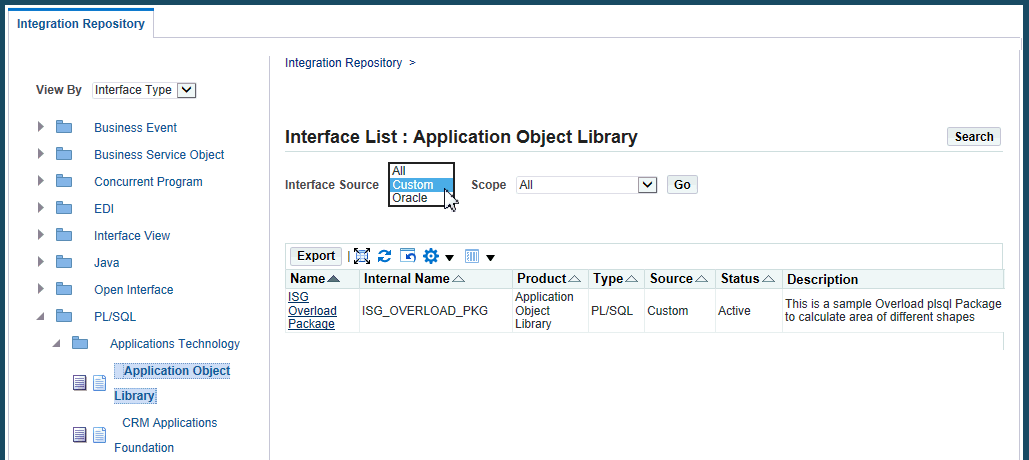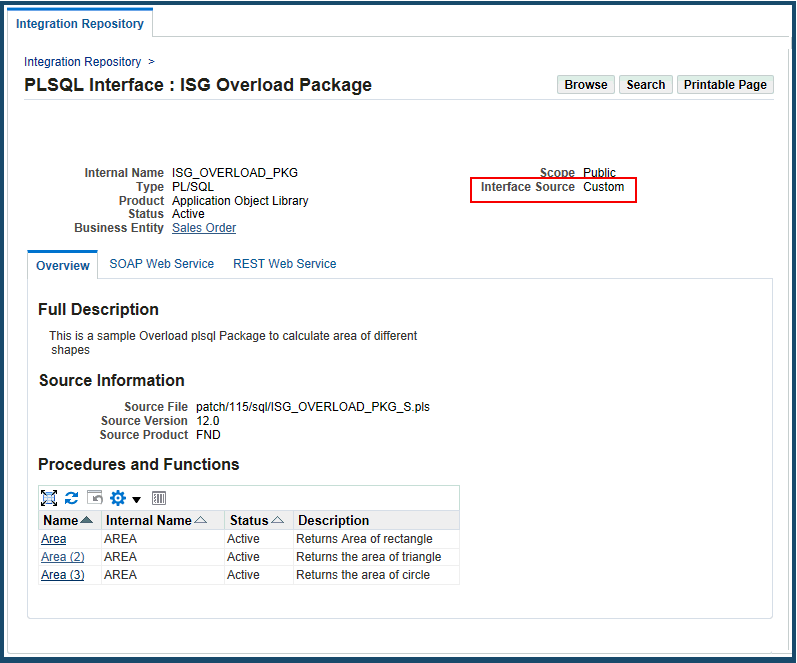Working with Custom Integration Interfaces
This chapter covers the following topics:
- Overview of Custom Integration Interfaces
- Searching Custom Integration Interfaces
- Viewing Custom Interface Details
- Performing Additional Activities for Custom Integration Interfaces
Overview of Custom Integration Interfaces
Oracle E-Business Suite Integrated SOA Gateway supports custom integration interfaces and allows them to be published along with Oracle seeded ones through the Oracle Integration Repository where they can be exposed to all users.
Integration developers create and annotate custom integration interfaces based on the Integration Repository annotation standards. Integration administrators use a standalone design-time tool to validate these annotated source files against the annotation standards. After validation, a loader file is generated and then uploaded to the Integration Repository through backend processing. These custom interfaces are displayed based on the interface types to which they belong and displayed together with Oracle seeded ones from the Integration Repository user interface.
Supported custom interface types include XML Gateway Map, Business Event, PL/SQL, Concurrent Program, Business Service Object, Java APIs, Java Bean Services, Application Module Services, and Composite Service - BPEL type.
Note: Custom interface types of EDI, Open Interface Tables, Interface Views, and Java APIs for Forms interfaces are not supported in this release.
Oracle Integration Repository currently does not support the creation of custom Product Family and custom Business Entity.
To easily distinguish annotated custom interface definitions from Oracle seeded interfaces, the Interface Source 'Custom' is used to categorize those custom integration interfaces in contrast to Interface Source 'Oracle' for Oracle interfaces.
For information on Integration Repository annotation standards, refer to:
-
Integration Repository Annotation Standards, Oracle E-Business Suite Integrated SOA Gateway Developer's Guide
-
Oracle Application Framework Developer's Guide, available from My Oracle Support Knowledge Document 1315485.1
The following topics explain more about how to search, view, and administer custom integration interfaces:
Searching Custom Integration Interfaces
Use the following ways to locate custom integration interfaces from the Integration Repository user interface:
-
From the Interface List page, select 'Custom' from the Interface Source drop-down list along with a value for the Scope field to restrict the custom integration interfaces display.
Interface List Page with "Custom" Selected as the Interface Source

-
From the Search page, click Show More Search Options to select 'Custom' from the Interface Source drop-down list along with any interface type, product family, or scope if needed as the search criteria.
Search Page with "Custom" Selected as the Interface Source

For example, select 'Custom' as the Interface Source and 'PL/SQL' as the Interface Type to locate the custom interfaces for PL/SQL type.
To view the custom integration interface details page:
-
Log in to Oracle E-Business Suite as a user who has the Integration Analyst role. Select the Integration Repository responsibility and then choose the Integration Repository link from the navigation menu. This opens the repository browser.
-
Locate custom integration interface definitions using the following two ways:
-
From the Interface List page
Select the following values:
-
Interface Source: Custom
-
Scope: Select an appropriate value
-
-
From the Search page
-
Click Show More Search Options to open more search options.
-
Select the following values:
-
Interface Source: Custom
-
Scope: Select an appropriate value
-
Product Family: Select an appropriate value
-
-
-
-
Click Go to run the search.
Custom integration interfaces that match your search criteria are displayed in table format.
-
Click a desired custom interface name from the search result to view the interface details.
The custom integration interface details page shows 'Custom' as the Interface Source value allowing you to differentiate it from an Oracle seeded one.
Viewing Custom Interface Details
After performing a search on custom integration interfaces, you can view the custom interface details by selecting a custom interface name from the search result table. Custom interface information including name, description, and other annotated information is displayed in the details page.
Note that all custom interface definitions have 'Custom' value displayed in the Interface Source field indicating that they are custom interfaces in contrast to Oracle seeded ones that have the Interface Source 'Oracle'.
Interface Details Page with Interface Source "Custom" Highlighted

Similar to native integration interfaces described in an earlier chapter, you may find additional interface or web service information in this page depending on the interface type you select. For example, if it is a custom PL/SQL API or concurrent program, you can find the Overview tab, SOAP Web Service tab, and REST Web Service tab in the interface details page.
Users who have the Integration Administrator role can perform administrative tasks during the service development life cycle, see Performing Additional Web Service Activities for Custom Integration Interfaces.
Performing Additional Activities for Custom Integration Interfaces
In addition to viewing custom integration interface details, users who have the Integration Administrator role can perform the following administrative tasks:
-
Deleting Custom Integration Interfaces
If a custom integration interface is not yet generated or deployed as a web service, users who have the Integration Administrator role can delete the custom interface by clicking Delete Interface in the Overview tab of the custom interface details page.
Once a custom interface has been generated or deployed, it must be reset or undeployed to its initial state before it can be deleted.
See: Deleting Custom Integration Interfaces, Oracle E-Business Suite Integrated SOA Gateway Implementation Guide.
-
Managing Custom Web Service Lifecycle Activities
For Custom Interfaces with Support for SOAP Web Services
-
Managing Security Grants for Custom SOAP Services
To use custom interfaces and services, users who have the Integration Administrator role need to grant the custom interfaces access privileges to a user, user group, or all users. Additionally, the administrators can revoke the grants that have been created earlier if needed.
See: Managing Security Grants for SOAP Web Services Only, Oracle E-Business Suite Integrated SOA Gateway Implementation Guide.
-
Generating Custom SOAP Web Services
Users who have the Integration Administrator role or the Integration Developer role can transform custom integration definitions into SOAP services with desired interaction patterns.
Note: Integration developers have the privilege to generate web services, but they cannot deploy or undeploy services.
See: Generating SOAP Web Services, Oracle E-Business Suite Integrated SOA Gateway Implementation Guide.
-
Deploying Custom SOAP Web Services
If a custom SOAP service has been successfully generated, users who have the Integration Administrator role can deploy the generated custom SOAP service with an appropriate authentication type.
-
Undeploying Custom Web Services
If a custom SOAP service has been successfully deployed, the integration administrators can click Undeploy to undeploy the custom service that has been deployed earlier.
See: Deploying and Undeploying SOAP Web Services, Oracle E-Business Suite Integrated SOA Gateway Implementation Guide.
-
Resetting Custom SOAP Web Services
Once a custom service has been successfully generated or deployed, the integration administrators can clear up existing service artifacts if needed by clicking Reset.
See: Resetting SOAP Web Services, Oracle E-Business Suite Integrated SOA Gateway Implementation Guide.
-
Retiring Custom SOAP Web Services
When a custom service has been deployed to Oracle SOA Suite with active state, the integration administrators can retire the deployed custom service and ensure that all current running requests are completed.
See: Retiring SOAP Web Services, Oracle E-Business Suite Integrated SOA Gateway Implementation Guide.
-
Activating Custom SOAP Web Services
For a retired custom SOAP service in Oracle SOA Suite, the integration administrators can activate the retired service by clicking Activate in the interface details page. This lets a retired custom service become active again.
See: Activating SOAP Web Services, Oracle E-Business Suite Integrated SOA Gateway Implementation Guide.
-
Viewing Log Messages
To effectively troubleshoot any issues or exceptions encountered at each stage of service generation and deployment life cycle, the integration administrators can view design-time logs recorded for a custom SOAP service through the SOAP Web Service tab of the interface details page, and runtime logs through Service Monitor for an interface if the design-time log and runtime log are enabled for the SOAP service type respectively.
For information on how to view design-time logs for SOAP services, see Viewing Design-Time Logs for SOAP Services, Oracle E-Business Suite Integrated SOA Gateway Implementation Guide.
For information on how to view runtime logs, see Viewing Service Processing Logs, Oracle E-Business Suite Integrated SOA Gateway Implementation Guide.
For detailed information about administrative tasks, see Administering SOAP Web Services, Oracle E-Business Suite Integrated SOA Gateway Implementation Guide.
For Custom Interfaces with Support for REST Web Services
Note: Supported interfaces for custom REST services are PL/SQL APIs, Concurrent Programs, Business Service Objects, Java Bean Services, and Application Module Services. Although Open Interface Tables and Views can be exposed as REST services, custom interfaces of this interface type are not supported.
-
Managing Security Grants for Custom REST Services
Similar to managing the grants for custom SOAP services, to let Oracle E-Business Suite users have the access permissions to the custom interfaces that can be exposed as REST services, users who have the Integration Administrator role need to create new security grants for these custom interfaces and services.
The administrators can revoke existing grants to remove the access privileges from the users who have been granted the custom interfaces access.
See: Managing Grants for Interfaces with Support for SOAP and REST Web Services, Oracle E-Business Suite Integrated SOA Gateway Implementation Guide.
-
Deploying Custom REST Web Services
Before deploying a custom interface as a REST service, the administrator must specify service alias for the selected interface in the Service Operations table and ensure that at least one authentication type is selected in the REST Service Security region. If the selected custom interface type is PL/SQL, Business Service Object, Java Bean Services, or Application Module Services, the administrator also needs to specify HTTP verbs for desired methods contained in the selected interface before deployment.
See: Deploying REST Web Services, Oracle E-Business Suite Integrated SOA Gateway Implementation Guide.
-
Undeploying Custom REST Web Services
If a REST service has been successfully deployed, the integration administrators can click Undeploy to undeploy the REST service if necessary.
See: Undeploying REST Web Services, Oracle E-Business Suite Integrated SOA Gateway Implementation Guide.
-
Viewing Log Messages
Similar to viewing log messages for custom SOAP services, the integration administrators can view log messages recorded specifically for the REST service deployment activities through the REST Web Service tab and the runtime logs through Service Monitor for an interface if the design-time log and runtime log are enabled for the REST service type respectively.
For information on how to view design-time logs for REST services, see Viewing Design-Time Logs for REST Services, Oracle E-Business Suite Integrated SOA Gateway Implementation Guide.
For information on how to view runtime logs, see Viewing Service Processing Logs, Oracle E-Business Suite Integrated SOA Gateway Implementation Guide.
For detailed information about administrative tasks, see Administering REST Web Services, Oracle E-Business Suite Integrated SOA Gateway Implementation Guide.
-
-
Subscribing to Custom Business Events
The integration administrators can subscribe to a custom business event by clicking Subscribe in the business event interface details page. This creates subscription for the selected custom event.
See: Subscribing to Business Events, Oracle E-Business Suite Integrated SOA Gateway Implementation Guide.
-
Viewing and Downloading Custom Composite Services - BPEL
-
Viewing Custom Composite Services - BPEL
To view a custom composite service - BPEL, perform a search from the Search page and click Show More Search Options to display more search fields. Enter the following values in the Search page along with product family, scope, or any other values if needed to locate desired custom composite interfaces:
-
Interface Source: Custom
-
Interface Type: Composite
-
-
Downloading Custom Composite Services - BPEL
Similar to downloading composite services, users who have the download privilege can download a custom composite - BPEL .JAR file to their local directories by clicking Download Service in the interface details page.
See: Downloading Composite Services - BPEL, Oracle E-Business Suite Integrated SOA Gateway Implementation Guide.
-